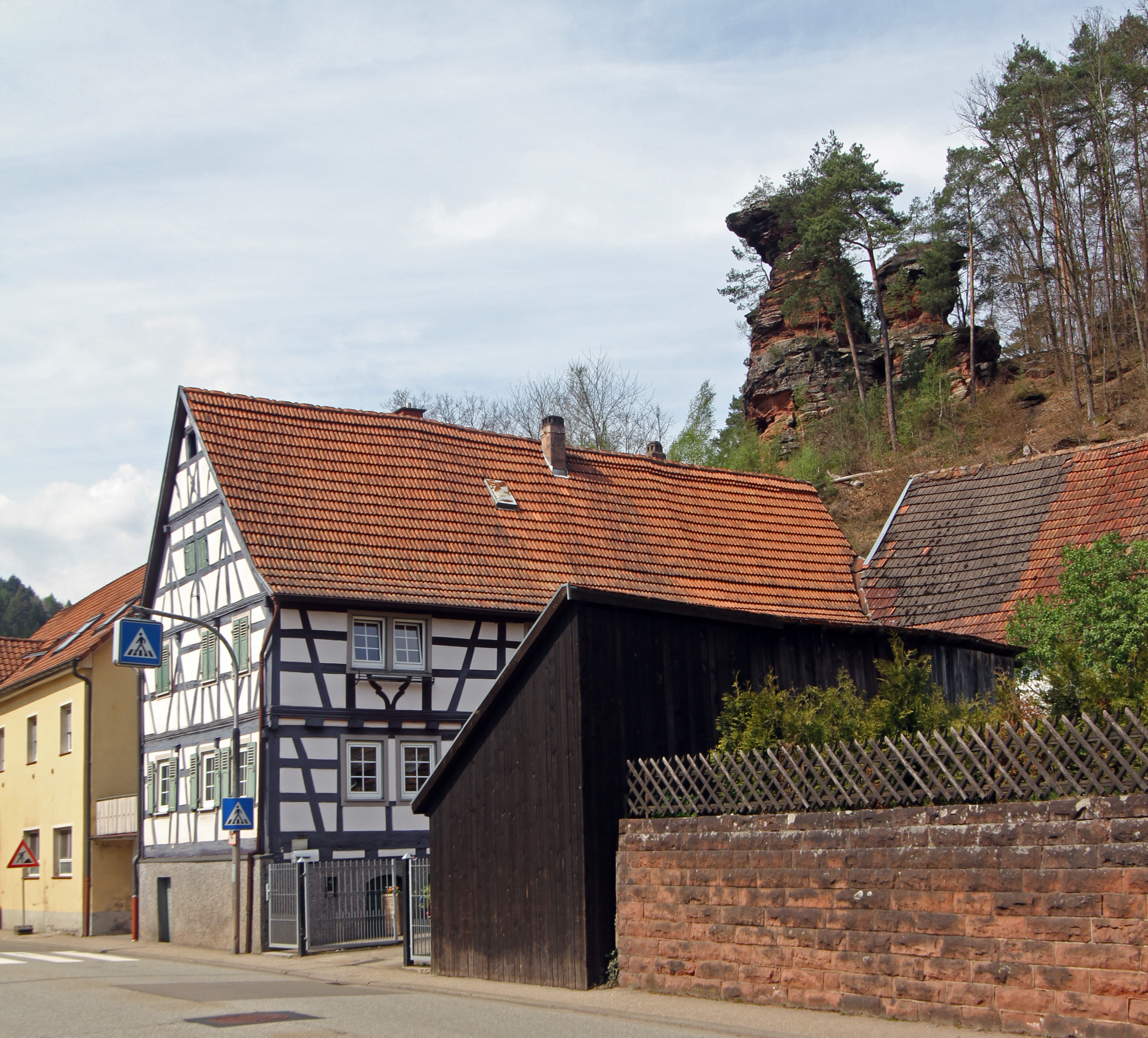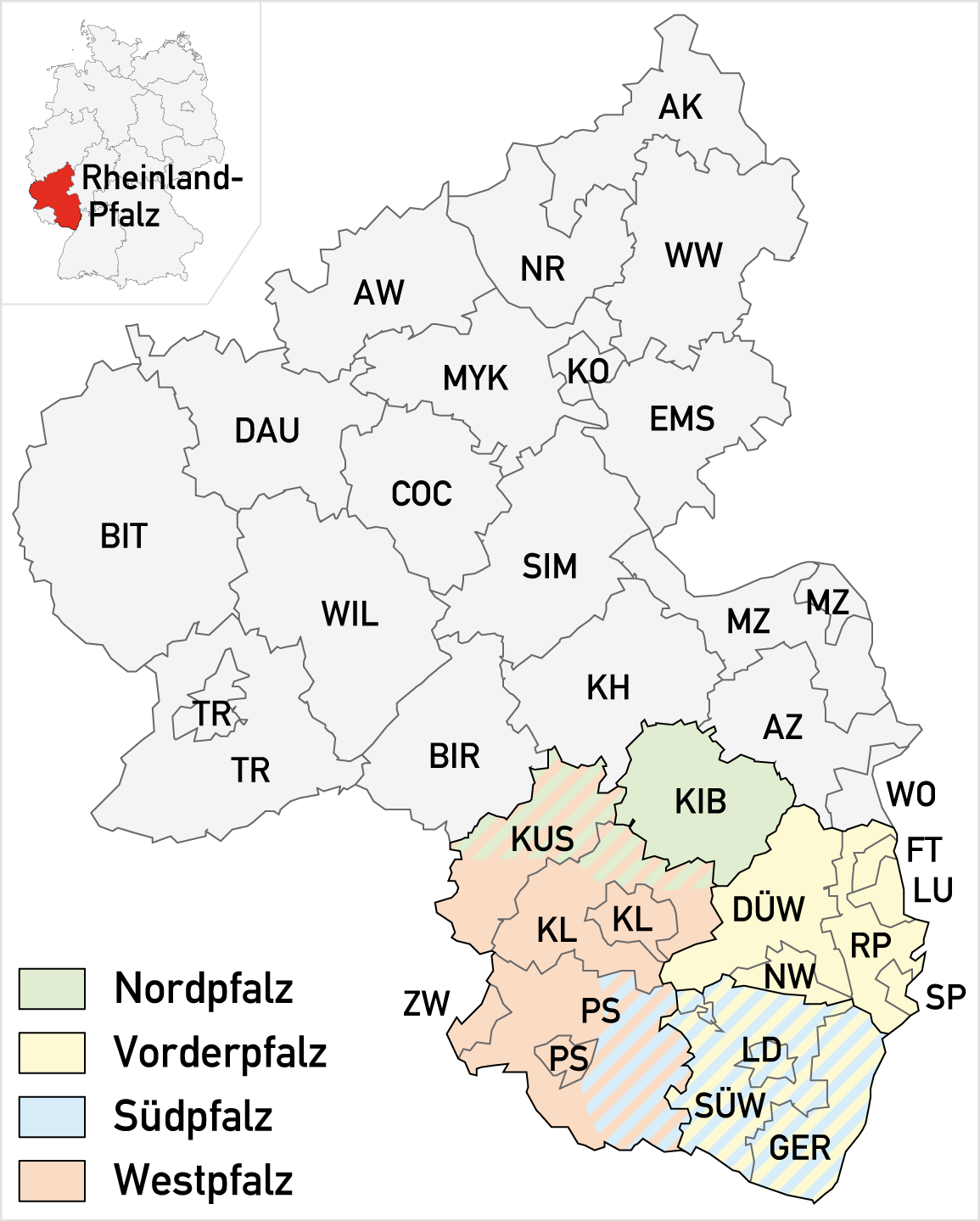|
Hinterweidenthal Ost Station
Hinterweidenthal Ost station (originally called Kaltenbach Ost and later called Hinterweidenthal until 1970) is one of a total of three stations in the municipality of Hinterweidenthal in the German state of Rhineland-Palatinate. Deutsche Bahn classifies it as a German railway station categories, category 6 station and it has two platform tracks. The station is located in the network of the Verkehrsverbund Rhein-Neckar (Rhine-Neckar transport association, VRN) and belongs to fare zone 998. It was opened in 1911 as a junction station for the newly built Wieslauter Railway to Bundenthal. Its importance has always been as an interchange station between the latter and the Landau–Rohrbach railway, which has existed in its present form since 1895. After passenger services were abandoned at the station, it functioned exclusively as a depot for railway operations and as a freight yard. After traffic on the Wieslauter line was reactivated on weekends in 1997, it has again been served by ... [...More Info...] [...Related Items...] OR: [Wikipedia] [Google] [Baidu] |
Hinterweidenthal
Hinterweidenthal is a municipality in Südwestpfalz district, in Rhineland-Palatinate, western Germany Germany,, officially the Federal Republic of Germany, is a country in Central Europe. It is the second most populous country in Europe after Russia, and the most populous member state of the European Union. Germany is situated betwe .... References Municipalities in Rhineland-Palatinate Palatinate Forest South Palatinate Südwestpfalz {{Südwestpfalz-geo-stub ... [...More Info...] [...Related Items...] OR: [Wikipedia] [Google] [Baidu] |
Hinterweidenthal Ort Station
Hinterweidenthal is a municipality in Südwestpfalz district, in Rhineland-Palatinate, western Germany. References Municipalities in Rhineland-Palatinate Palatinate Forest South Palatinate Südwestpfalz {{Südwestpfalz-geo-stub ... [...More Info...] [...Related Items...] OR: [Wikipedia] [Google] [Baidu] |
Landau (Pfalz) Hauptbahnhof
Landau (Pfalz) Hauptbahnhof (Landau (Pfalz) main station) is the centre of public transport in the city of Landau in the German state of Rhineland-Palatinate. History The history of the station begins in 1855, when the Palatine Maximilian Railway was opened on the Neustadt–Landau– Winden– Wissembourg route. In 1872, a new station building was built in the Romanesque revival style, replacing the original timber building. In the same year, the Lower Queich Valley Railway (''Untere Queichtalbahn'') was opened from Germersheim to Landau. The Landau–Rohrbach railway (also known as the ''Queichtalbahn''—"Queich Valley Railway"), connecting Landau, Annweiler, Biebermühle and Zweibrücken, was opened in 1874/5. Long distance trains ran in all directions, on the Amsterdam–Bingerbrück–Bad Kreuznach–Neustadt–Landau–Strasbourg–Basel route and on the Munich– Ulm–Stuttgart–Bruchsal–Germersheim–Landau–Biebermühle–Zweibrücken–Saarbrücken route. In ... [...More Info...] [...Related Items...] OR: [Wikipedia] [Google] [Baidu] |
Relay Interlocking
In railway signalling, an interlocking is an arrangement of signal apparatus that prevents conflicting movements through an arrangement of tracks such as junctions or crossings. The signalling appliances and tracks are sometimes collectively referred to as an ''interlocking plant''. An interlocking is designed so that it is impossible to display a signal to proceed unless the route to be used is proven safe. Interlocking is a safety measure designed to prevent signals and points/switches from being changed in an improper sequence. For example interlocking would prevent a signal from being changed to indicate a diverging route, unless the corresponding points/switches had been changed first. In North America, the official railroad definition of interlocking is: "''An arrangement of signals and signal appliances so interconnected that their movements must succeed each other in proper sequence''". Configuration and use A minimal interlocking consists of signals, but usually i ... [...More Info...] [...Related Items...] OR: [Wikipedia] [Google] [Baidu] |
Dormer
A dormer is a roofed structure, often containing a window, that projects vertically beyond the plane of a pitched roof. A dormer window (also called ''dormer'') is a form of roof window. Dormers are commonly used to increase the usable space in a loft and to create window openings in a roof plane. A dormer is often one of the primary elements of a loft conversion. As a prominent element of many buildings, different types of dormer have evolved to complement different styles of architecture. When the structure appears on the spires of churches and cathedrals, it is usually referred to as a ''lucarne''. History The word ''dormer'' is derived from the Middle French , meaning "sleeping room", as dormer windows often provided light and space to attic-level bedrooms. One of the earliest uses of dormers was in the form of lucarnes, slender dormers which provided ventilation to the spires of English Gothic churches and cathedrals. An early example are the lucarnes of the spire of C ... [...More Info...] [...Related Items...] OR: [Wikipedia] [Google] [Baidu] |
Mansard Roof
A mansard or mansard roof (also called a French roof or curb roof) is a four-sided gambrel-style hip roof characterised by two slopes on each of its sides, with the lower slope, punctured by dormer windows, at a steeper angle than the upper. The steep roof with windows creates an additional floor of habitable space (a garret), and reduces the overall height of the roof for a given number of habitable storeys. The upper slope of the roof may not be visible from street level when viewed from close proximity to the building. The earliest known example of a mansard roof is credited to Pierre Lescot on part of the Louvre built around 1550. This roof design was popularised in the early 17th century by François Mansart (1598–1666), an accomplished architect of the French Baroque period. It became especially fashionable during the Second French Empire (1852–1870) of Napoléon III. ''Mansard'' in Europe (France, Germany and elsewhere) also means the attic or garret space itself, not ... [...More Info...] [...Related Items...] OR: [Wikipedia] [Google] [Baidu] |
Gable
A gable is the generally triangular portion of a wall between the edges of intersecting roof pitches. The shape of the gable and how it is detailed depends on the structural system used, which reflects climate, material availability, and aesthetic concerns. The term gable wall or gable end more commonly refers to the entire wall, including the gable and the wall below it. Some types of roof do not have a gable (for example hip roofs do not). One common type of roof with gables, the gable roof, is named after its prominent gables. A parapet made of a series of curves (Dutch gable) or horizontal steps (crow-stepped gable) may hide the diagonal lines of the roof. Gable ends of more recent buildings are often treated in the same way as the Classic pediment form. But unlike Classical structures, which operate through trabeation, the gable ends of many buildings are actually bearing-wall structures. Gable style is also used in the design of fabric structures, with varying degree ... [...More Info...] [...Related Items...] OR: [Wikipedia] [Google] [Baidu] |
Hauenstein
Hauenstein is a municipality in the Südwestpfalz district, in Rhineland-Palatinate, Germany. It is situated in the Palatinate forest, approximately 20 km east of Pirmasens, and 20 km west of Landau. Hauenstein is the seat of the ''Verbandsgemeinde A Verbandsgemeinde (; plural Verbandsgemeinden) is a low-level administrative unit in the German federal states of Rhineland-Palatinate and Saxony-Anhalt. A Verbandsgemeinde is typically composed of a small group of villages or towns. Rhinelan ...'' ("collective municipality") Hauenstein. It is an important centre for the shoe industry, and is home to the German Shoe Museum (''Deutsches Schuhmuseum''). References Palatinate Forest South Palatinate Südwestpfalz {{Südwestpfalz-geo-stub ... [...More Info...] [...Related Items...] OR: [Wikipedia] [Google] [Baidu] |
Western Palatinate
Western Palatinate or West Palatinate (german: Westpfalz) is a sub-region in the west of the Palatinate, a German cultural and historic region in the state of Rhineland-Palatinate. It includes the western part of the Palatine Forest, the central part of the North Palatine Uplands, the West Palatine Moor and the Westrich Plateau. Its former name of "Further Palatinate" (''Hinterpfalz''), which emerged during the time of Bavarian rule in 1816 and was viewed by the local population as very discriminatory, is only commonly used in the Anterior Palatinate (''Vorderpfalz''). The following counties and independent towns or cities lie wholly or partly in the Western Palatinate: * County of Kaiserslautern * City of Kaiserslautern * County of Kusel * Town of Landstuhl * Town of Pirmasens * County of Südwestpfalz * Town of Zweibrücken The county of Donnersbergkreis and the old counties of Rockenhausen and Kirchheimbolanden were also counted as part of the Western Palatinate in th ... [...More Info...] [...Related Items...] OR: [Wikipedia] [Google] [Baidu] |
Deutsche Bundesbahn
The Deutsche Bundesbahn or DB (German Federal Railway) was formed as the state railway of the newly established Federal Republic of Germany (FRG) on 7 September 1949 as a successor of the Deutsche Reichsbahn-Gesellschaft (DRG). The DB remained the state railway of West Germany until after German reunification, when it was merged with the former East German Deutsche Reichsbahn (DR) to form Deutsche Bahn, which came into existence on 1 January 1994. Background After World War II, each of the military governments of the Allied Occupation Zones in Germany were ''de facto'' in charge of the German railways in their respective territories. On 10 October 1946, the railways in the British and American occupation zones formed the ''Deutsche Reichsbahn im Vereinigten Wirtschaftsgebiet'' (German Imperial Railway in the united economic area), while on 25 June 1947, the provinces under French occupation formed the Südwestdeutsche Eisenbahn. With the formation of the FRG these succe ... [...More Info...] [...Related Items...] OR: [Wikipedia] [Google] [Baidu] |







